link to page 4
 DRUG PROTOCOL
Anaesthetics: KETAMINE INFUSION FOR CHRONIC PAIN MANAGEMENT
Rationale:
DRUG PROTOCOL
Anaesthetics: KETAMINE INFUSION FOR CHRONIC PAIN MANAGEMENT
Rationale:
Medicines can only be administered in accordance with a prescription or a standing order. The use
of protocols and standing orders establishes procedures to be followed for the administration of
medications which wil allow safe, efficient and timely treatment of patients.
Standard:
Registered Health Professionals wil administer medications as per the protocol/guideline.
1. Scope:
Ketamine for analgesia is an unapproved indication, therefore within the NDHB it is to
be prescribed under the instruction of one of the following groups;
• Pain team (consultants, MOSSs, registrar)
• Palliative Care team (consultants, MOSSs)
• Anaesthetists.
2. Indications:
Control of pain associated with:
• Trauma or surgery where opioids are inef ective or where the dose of opioids is
limited by side effects and/or comorbidities
• Cancer and chronic benign pain conditions
• Neuropathic syndromes
• Drug and Alcohol Services
• Procedures, such as change of dressings, debridement in burned patients
• Induction of anaesthesia
• Sole anaesthetic agent
• As a sedative for diagnostic and therapeutic procedures
• Adjunct to weaning of high use opiates only in collaboration with Drug and Alcohol
Services
under Official Information Act
3. Primary effects:
Ketamine hydrochloride is a rapid-acting non-barbiturate general anaesthetic agent whose
mechanism of action is complex. In sub-anaesthetic doses it is also a potent analgesic,
blocking conduction of painful stimuli, by binding to the N-Methyl-D-Aspartate (NMDA)
receptor implicated in "windup" in spinal dorsal horn neurones and the development of
opioid tolerance. It can thus be described as an NMDA antagonist.
4. Contraindications: (see also Other information: on page 4)
Released
• Any condition where a significant rise in blood pressure may be hazardous, such
as severe cardiovascular disease, heart failure, severe or poorly controlled
hypertension, angina, recent myocardial infarction, history of stroke
• Patients who have demonstrated an al ergy or previous intolerance to this
medicine.
NORTHLAND DISTRICT HEALTH BOARD
TITLE: Anaesthetics: KETAMINE INFUSION FOR CHRONIC PAIN MANAGEMENT
Page 1 of 6
FIRST ISSUED: July 2016
CURRENT ISSUE: Dec 2018
REVISION DATE: Dec 2020
AUTHORED BY: Jan Haraldsson, CNS
Medicines Committee Review: Oct 2016
Edited by: Bryce Kivel , Medication Safety/Quality Pharmacist
AUTHORISED BY: Dr Chanchal Ajodha, Anaesthetics Department – Pain management team.
If printed, this protocol is valid only for the day of printing or for the duration of a specific patient’s admission
25/01/2022
link to page 4

 DRUG PROTOCOL
Anaesthetics: KETAMINE INFUSION FOR CHRONIC PAIN MANAGEMENT
5. Cautions: (see also Monitoring: on page 4)
DRUG PROTOCOL
Anaesthetics: KETAMINE INFUSION FOR CHRONIC PAIN MANAGEMENT
5. Cautions: (see also Monitoring: on page 4)
Patients with:
• Head injuries and raised intra-cranial pressures (ICPs)
• Raised intraocular pressure
• History of psychiatric disorder
• Confusion
• History of seizure
• Hyperthyroidism
• Renal or hepatic impairment – dose reduction may need to be considered
Act
6. Dosage:
Ketamine infusion should be charted on the regular side of the medication chart, to be
administered as a continuous intravenous infusion via a dedicated Ketamine designated
pump.
As the Ketamine designated pumps are preset it is vital that the concentration of
ketamine in the infusion syringe is 1mg/ml. Alternative concentrations wil cause
unintentional under or overdosing of ketamine.
Information
The Ketamine infusion rate wil be prescribed on a variable rate determined by side effects
experienced by patient. The infusion rate wil be dependent on patient’s analgesic
requirements,
but settings wil only allow up to a maximum rate of 10mg/hr.
NB: In some instances, e.g. chronic pain patients may require a higher infusion rate.
This wil be determined by the prescribing anaesthetist.
Official
Chart on the REGULAR section of the National Medication Chart.
Ketamine 1mg/ml infusion
IV
under
continuous
Blah Blah Blah
ml/
hour
1 to 10
via ketamine pump
7. Administration:
There should not be any medication piggy backed through the background compatible IV
fluids while the Ketamine infusion is in progress due to probable interactions occurring.
Released
Ketamine is administered as a continuous infusion. When administered as an infusion, it is
preferable that the medication is given via a separate cannula to avoid peaks and troughs
in the serum concentration of the ketamine
. If this is not possible however, and when a
patient is
also on PCA, the ketamine can be piggy-backed through the IV fluids port of the
PCA giving set.
NORTHLAND DISTRICT HEALTH BOARD
TITLE: Anaesthetics: KETAMINE INFUSION FOR CHRONIC PAIN MANAGEMENT
Page 2 of 6
FIRST ISSUED: July 2016
CURRENT ISSUE: Dec 2018
REVISION DATE: Dec 2020
AUTHORED BY: Jan Haraldsson, CNS
Medicines Committee Review: Oct 2016
Edited by: Bryce Kivel , Medication Safety/Quality Pharmacist
AUTHORISED BY: Dr Chanchal Ajodha, Anaesthetics Department – Pain management team.
If printed, this protocol is valid only for the day of printing or for the duration of a specific patient’s admission
25/01/2022

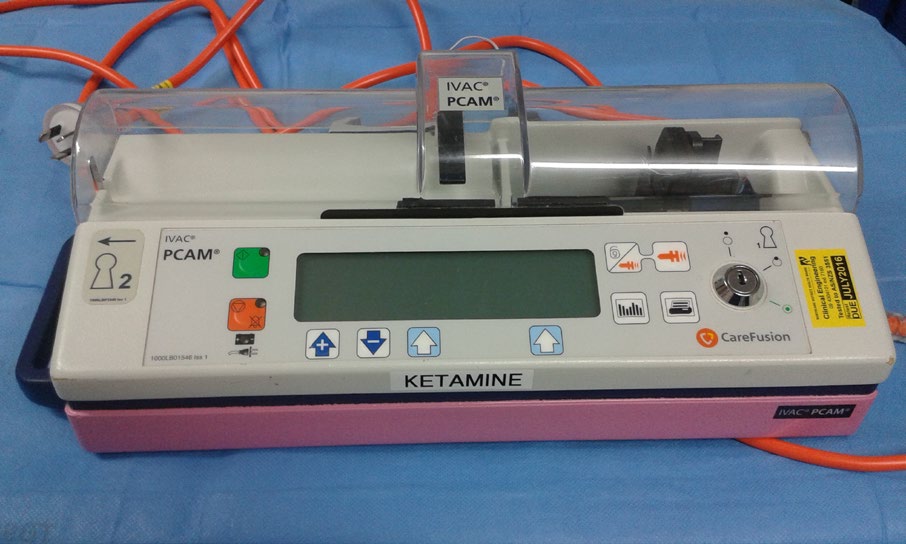 DRUG PROTOCOL
Anaesthetics: KETAMINE INFUSION FOR CHRONIC PAIN MANAGEMENT
8. Presentation:
DRUG PROTOCOL
Anaesthetics: KETAMINE INFUSION FOR CHRONIC PAIN MANAGEMENT
8. Presentation:
A 50ml infusion consisting of 50mg Ketamine (1mg/ml) in a 50ml syringe. Only infusion
preparations of ketamine 1mg/ml solution supplied in a 50 ml syringe should be administered
via a ketamine designated pump (shown below).
Ketamine
designated
pump – with
Act
PINK front
panel.
9. Preparation:
Level of competency required
• RN - IV designated & PCA Moodle completed (recommended)
This is a high risk medication requiring a 2 person independent second check
Information
Including checking patient ID and pump setup.
To prepare a 50ml ketamine intravenous infusion (IV) 1 mg/ml;
• Using a 50ml syringe ‘BD Plastipak 50ml’ draw up a 0.5ml volume of ketamine
200mg/2ml.
• Make up with
0.9% Sodium Chloride or 5% Dextrose to a total of 50ml to
Official
achieve a
concentration of 1mg/ml.
• Preparation not used within 24 hours should be discarded.
10. Equipment needed:
under
• Infusion is via a ketamine designated pump with pink painted front (will allow up to
a hard max 10mg/hr)
- Note: This pump does not require a bolus but on or an access code.
• Designated PCAM tubing – Order number: M13499
• Monitoring equipment –SpO2, BP, HR, RR
• Ketamine 200mg/2ml
• 0.9% sodium chloride for injection
• 50ml BD syringe
• Filter needle (if ketamine supplied in glass vials)
Released
• Medication label
• Emergency trolley available on ward
• Functioning oxygen/suction in room
NORTHLAND DISTRICT HEALTH BOARD
TITLE: Anaesthetics: KETAMINE INFUSION FOR CHRONIC PAIN MANAGEMENT
Page 3 of 6
FIRST ISSUED: July 2016
CURRENT ISSUE: Dec 2018
REVISION DATE: Dec 2020
AUTHORED BY: Jan Haraldsson, CNS
Medicines Committee Review: Oct 2016
Edited by: Bryce Kivel , Medication Safety/Quality Pharmacist
AUTHORISED BY: Dr Chanchal Ajodha, Anaesthetics Department – Pain management team.
If printed, this protocol is valid only for the day of printing or for the duration of a specific patient’s admission
25/01/2022
 DRUG PROTOCOL
Anaesthetics: KETAMINE INFUSION FOR CHRONIC PAIN MANAGEMENT
11. Monitoring:
DRUG PROTOCOL
Anaesthetics: KETAMINE INFUSION FOR CHRONIC PAIN MANAGEMENT
11. Monitoring:
Observations:
•
The Adult EWS chart wil be used to record observations.
• Record baseline observations i.e. BP, HR, resp rate, pain score (at rest and on
movement) and level of consciousness
• 30 minute SpO2, BP, HR, RR, Sedation Score, and Pain Score for at least 2
hours on commencement of infusion
• Commence 4 hourly observations (SpO2, BP, HR, RR, Sedation Score, and
Pain Score) once stable for 2 hours
Act
•
Any rate increase wil require 30 minute observations until stable then
revert back to 4 hourly.
• Post infusion cessation, continue monitoring patient (SpO2, BP, HR, RR,
Sedation Score, and Pain Score) half hourly for two hours , or longer if required
if the patient’s condition is not satisfactory i.e. not easily rouseable,
hallucinating, vital signs not within acceptable parameters
Considerations:
• Patient remains awake
Information
• Minimise any excessive stimuli to patient
• Explain the possibility of side effects, e.g. hallucinations, excessive salivation,
nausea and vomiting
• Patient may feel drowsy, but sedation is likely to be minimal
• If possible maintain staff continuity while patient is receiving ketamine infusion
• Review with pain team daily for follow up and any other IV/SC analgesia
Official
(possible interaction) during ketamine infusion
• Contact the Inpatient Pain Service: ph 021 446 375/ #9402
Or On call
anaesthetist after hours and weekends if requires more than daily review
12. Other information: under
Adverse effects
Neurological
Psychomimetic reactions can include alteration of body image, floating sensations,
extracorporeal experiences, vivid dreams, agitation, and frank hallucinations.
Cardiovascular
Ketamine stimulates the sympathetic nervous system, resulting in a noticeable increase in
Released
heart rate and blood pressure. This can precipitate angina in at-risk patients.
13. References:
1.
New Zealand Formulary, release 39 - 01 September 2015, [online] (accessed 10/9/15)
2. Waikato DHB and Auckland DHB provided support with their current protocols to use
guidelines
NORTHLAND DISTRICT HEALTH BOARD
TITLE: Anaesthetics: KETAMINE INFUSION FOR CHRONIC PAIN MANAGEMENT
Page 4 of 6
FIRST ISSUED: July 2016
CURRENT ISSUE: Dec 2018
REVISION DATE: Dec 2020
AUTHORED BY: Jan Haraldsson, CNS
Medicines Committee Review: Oct 2016
Edited by: Bryce Kivel , Medication Safety/Quality Pharmacist
AUTHORISED BY: Dr Chanchal Ajodha, Anaesthetics Department – Pain management team.
If printed, this protocol is valid only for the day of printing or for the duration of a specific patient’s admission
25/01/2022

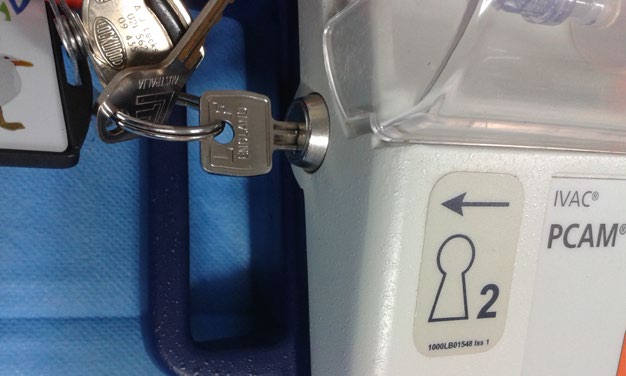
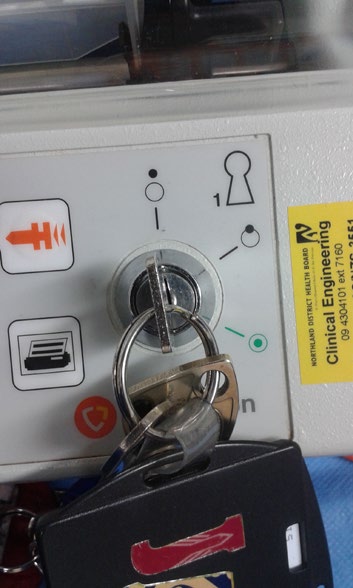
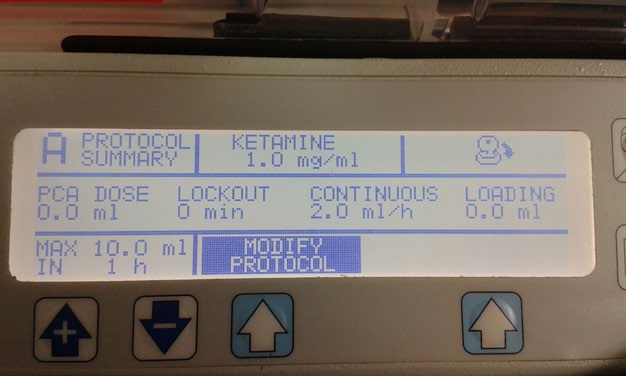
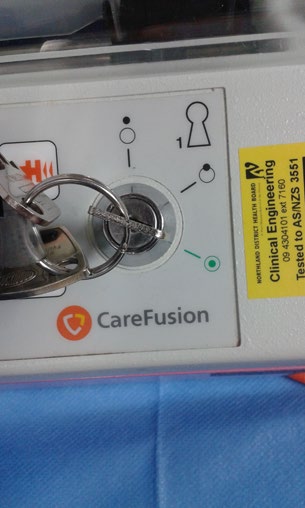
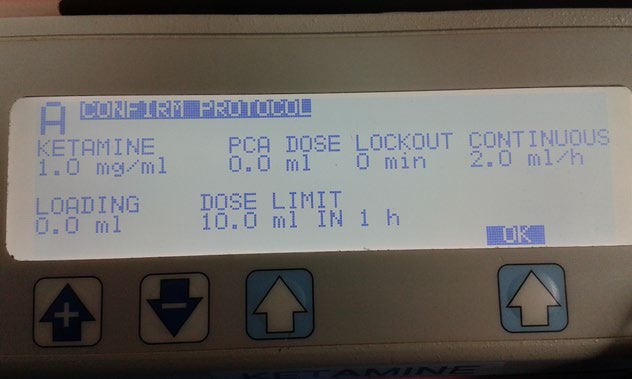
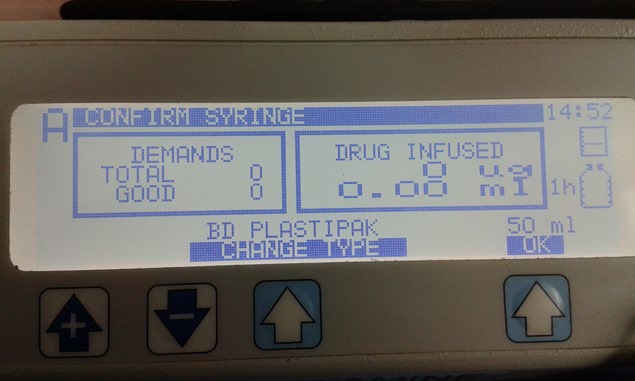
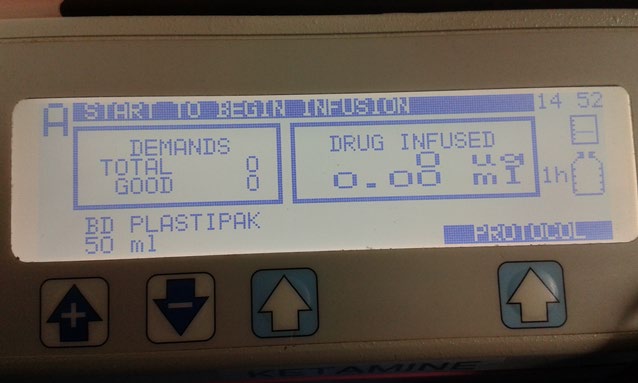
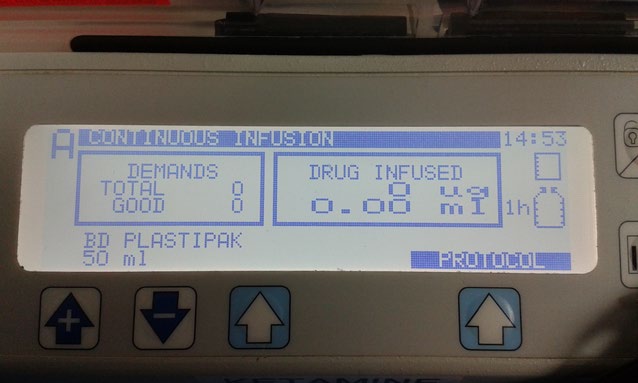
 DRUG PROTOCOL
Anaesthetics: KETAMINE INFUSION FOR CHRONIC PAIN MANAGEMENT
DRUG PROTOCOL
Anaesthetics: KETAMINE INFUSION FOR CHRONIC PAIN MANAGEMENT
Unlock
Setting up the ketamine
cover to
designated pump for
insert
ketamine infusion
prepared
ketamine
syringe.
Act
Close cover,
insert key
into key
space 1
“Continuous Infusion”
should be flashing
Turn key to mid
Information
setting. If new
patient, select
“Yes” to clear
previous patient
info
Press the green button to start
Official
infusion
Confirm
under
protocol as
per
prescription
chart
Press “OK” to confirm 50ml
BD Plastipak syringe
Released
Turn
Press
key to
“OK” to
green
confirm
protocol
NORTHLAND DISTRICT HEALTH BOARD
TITLE: Anaesthetics: KETAMINE INFUSION FOR CHRONIC PAIN MANAGEMENT
Page 5 of 6
FIRST ISSUED: July 2016
CURRENT ISSUE: Dec 2018
REVISION DATE: Dec 2020
AUTHORED BY: Jan Haraldsson, CNS
Medicines Committee Review: Oct 2016
Edited by: Bryce Kivel , Medication Safety/Quality Pharmacist
AUTHORISED BY: Dr Chanchal Ajodha, Anaesthetics Department – Pain management team.
If printed, this protocol is valid only for the day of printing or for the duration of a specific patient’s admission
25/01/2022

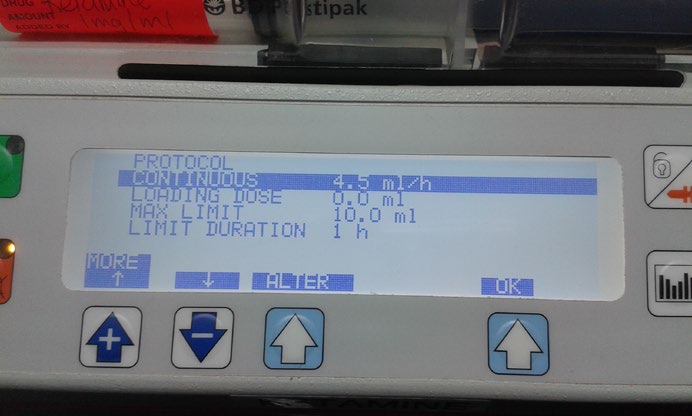
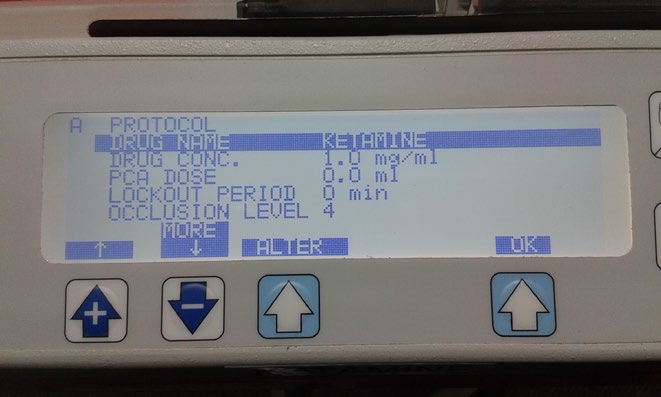
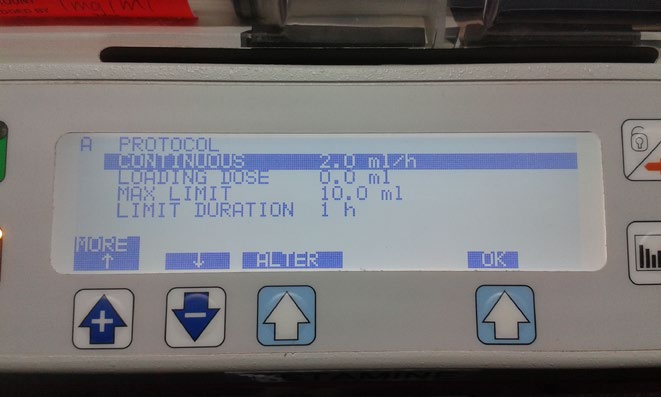

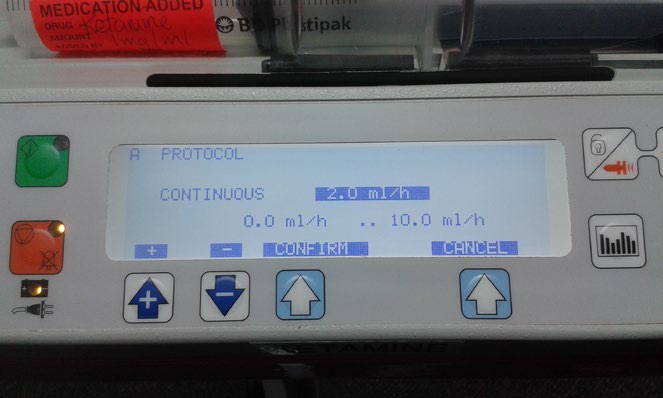
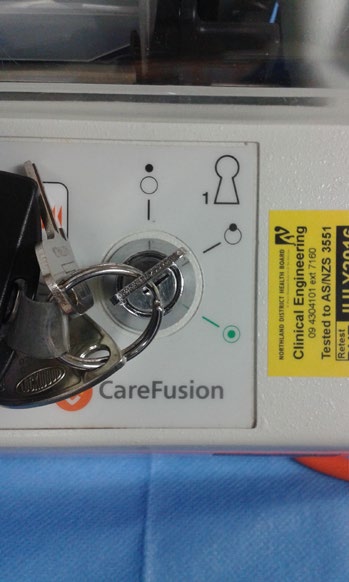
 DRUG PROTOCOL
Anaesthetics: KETAMINE INFUSION FOR CHRONIC PAIN MANAGEMENT
Instructions on how to change
ketamine infusion rate
DRUG PROTOCOL
Anaesthetics: KETAMINE INFUSION FOR CHRONIC PAIN MANAGEMENT
Instructions on how to change
ketamine infusion rate
Turn key to mid
setting to change
infusion rate.
Enter “NO” to
Follow instructions as per flow chart above:
keep current
-Turn key to green
patient
-Confirm protocol is correct against
information
prescription
Act
-Press OK
-Then press green button to start infusion
-Remove key
Press arrow
below
“modify
protocol”
Information
Press arrow
below “More
↓” to get to
“Continuous”
Official
Press the arrow below
“OK”
Press arrow
under below
“Alter”
Use the “+”
Released or “–“
arrows to
Once desired rate has been
change the
entered, press the arrow below
rate
“Confirm”
NORTHLAND DISTRICT HEALTH BOARD
TITLE: Anaesthetics: KETAMINE INFUSION FOR CHRONIC PAIN MANAGEMENT
Page 6 of 6
FIRST ISSUED: July 2016
CURRENT ISSUE: Dec 2018
REVISION DATE: Dec 2020
AUTHORED BY: Jan Haraldsson, CNS
Medicines Committee Review: Oct 2016
Edited by: Bryce Kivel , Medication Safety/Quality Pharmacist
AUTHORISED BY: Dr Chanchal Ajodha, Anaesthetics Department – Pain management team.
If printed, this protocol is valid only for the day of printing or for the duration of a specific patient’s admission
25/01/2022























